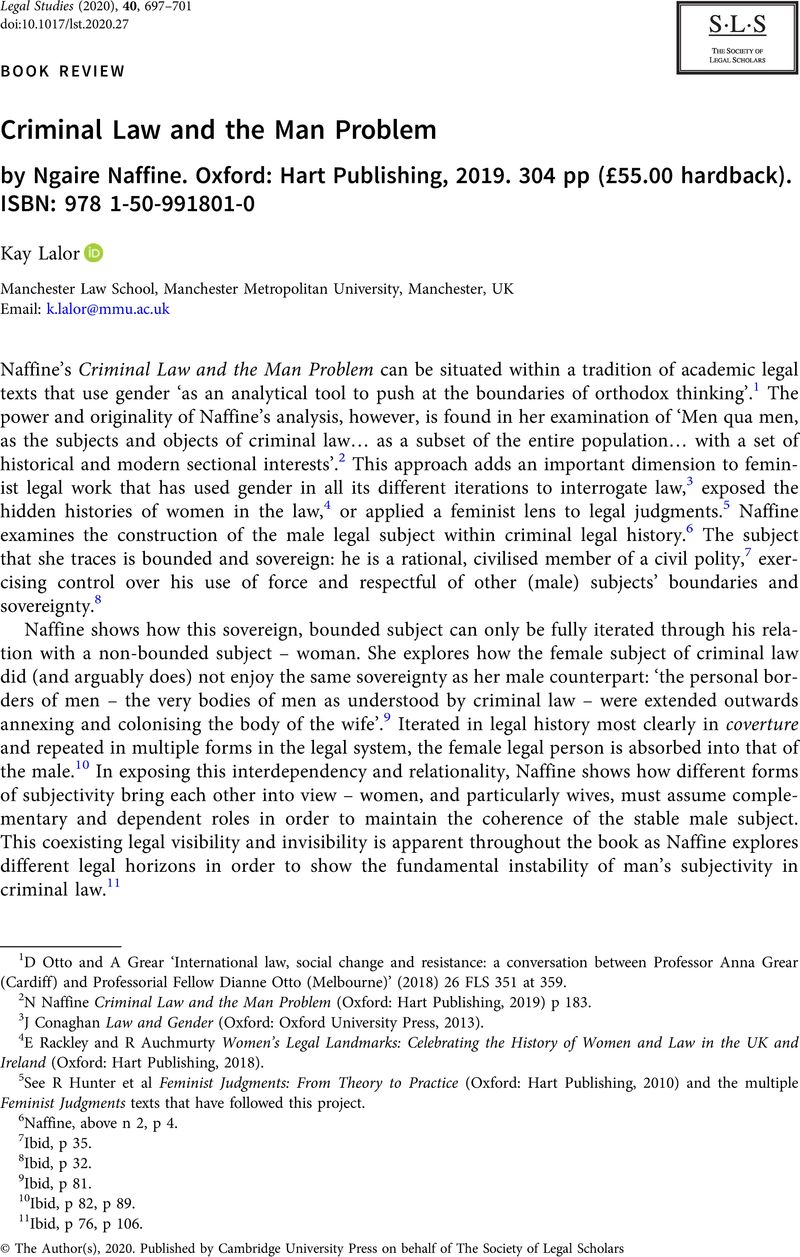No CrossRef data available.
Published online by Cambridge University Press: 03 August 2020

1 Otto, D and Grear, A ‘International law, social change and resistance: a conversation between Professor Anna Grear (Cardiff) and Professorial Fellow Dianne Otto (Melbourne)’ (2018) 26 FLS 351Google Scholar at 359.
2 Naffine, N Criminal Law and the Man Problem (Oxford: Hart Publishing, 2019) p 183CrossRefGoogle Scholar.
3 Conaghan, J Law and Gender (Oxford: Oxford University Press, 2013)CrossRefGoogle Scholar.
4 Rackley, E and Auchmurty, R Women's Legal Landmarks: Celebrating the History of Women and Law in the UK and Ireland (Oxford: Hart Publishing, 2018)Google Scholar.
5 See Hunter, R et al. Feminist Judgments: From Theory to Practice (Oxford: Hart Publishing, 2010)Google Scholar and the multiple Feminist Judgments texts that have followed this project.
6 Naffine, above n 2, p 4.
7 Ibid, p 35.
8 Ibid, p 32.
9 Ibid, p 81.
10 Ibid, p 82, p 89.
11 Ibid, p 76, p 106.
12 Ibid, p 22, but note that Naffine is clear that a series of ‘satellite laws’, such as assault, are also associated with the marital rape exemption.
13 [1975] UKHL 3.
14 Halisham LJ, 14 in Naffine, above n 2, p 10.
15 Naffine, above n 2, p 11.
16 Ibid, p 7.
17 Ibid, p 18.
18 Ibid, p 3.
19 Duff, in ibid, p 21.
20 Ibid, p 3.
21 As explored in depth in relation to G v G [1924] AC 349, ibid, p 91. However, when these naturalist justifications fail, particularly when law's brutality is revealed – as in the case of R v Clarence (1888) 22 QBD 23 in which Clarence's conviction for inflicting grievous bodily harm on his wife by transmission of gonorrhoea was overturned – Naffine shows how jurists and judges were willing to adopt a strict positivist stance rather than facing the contradictions inherent in the supposedly ‘natural’ legal position of men and women. This allowed the justification for immunity to remain a moving target dependent upon the legal horizon in view.
22 Ibid, p 87, p 136.
23 Eg Samuels, H ‘International Women's Day 2019: in conversation with Harriet Wistrich’ (2019) 27 FLS 311Google Scholar at 315; Milne, E ‘Concealment of birth: time to repeal a 200-year-old “convenient stop-gap”?’ (2019) 27 FLS 139Google Scholar; Douglas, H ‘Battered women's experiences of the criminal justice system: decentring the law’ (2012) 20 FLS 121Google Scholar; Tapia, S Tapia ‘Feminism and penal expansion: the role of rights-based criminal law in post-neoliberal Ecuador’ (2018) 26 FLS 285Google Scholar; Kim, ME ‘Anti-carceral feminism: the contradictions of progress and the possibilities of counter-hegemonic struggle’ (2019) Affilia 1Google Scholar; Richie, BE and Martensen, KM ‘Resisting carcerality, embracing abolition: implications for feminist social work practice’ (2020) 35 Affilia 12CrossRefGoogle Scholar.
24 Naffine, above n 2, p 121, p 136.
25 Ibid, p 187.
26 Eg Galloway, K ‘The role of Pateman's sexual contract in beneficial interests in property’ (2019) 27 FLS 263Google Scholar.
27 There is also space here to consider women who challenged regimes of gender or civilisation, although this is less central to the focus on the male criminal legal subject.
28 Naffine, above n 2, pp 145–146.
29 Ibid, p 146.
30 Dudgeon v UK (1981) 3 EHRR 40; Toonen v Australia, CCPR/C/50/D/488/1992; UN Human Rights Committee (HRC), 4 April 1994.
31 See for example the work of Queer Beyond London, at http://queerbeyondlondon.com/about/.
32 Weber, C Queer International Relations: Sovereignty, Sexuality and the Will to Knowledge (Oxford: Oxford University Press, 2016) p 6Google Scholar.
33 Naffine, above n 2, p 35.
34 Ibid, p 123.
35 Ibid, p 59.
36 Benton, L and Ford, L Rage for Order The British Empire and the Origins of International Law, 1800–1850 (Harvard University Press, 2016)CrossRefGoogle Scholar.
37 Kirby, M ‘The sodomy offence: England's least lovely criminal law export?’ in Lennox, C and Waites, M (eds), Human Rights, Sexual Orientation and Gender Identity in The Commonwealth: Struggles for Decriminalisation and Change (London: Institute of Commonwealth Studies, 2013) p 65Google Scholar.
38 Anghie, A Imperialism, Sovereignty and the Making of International Law (Cambridge: Cambridge University Press, 2007)Google Scholar.
39 Naffine, above n 2, p 30.
40 In an immigration law context see El-Enany, N Bordering Britain: Law, Race and Empire (Manchester: Manchester University Press, 2020)Google Scholar; see also Williams, P and Clarke, B ‘The black criminal other as an object of social control’ (2018) 7 Social Sciences 1CrossRefGoogle Scholar.
41 Naffine, above n 2, p 139.
42 Ibid, p 187.